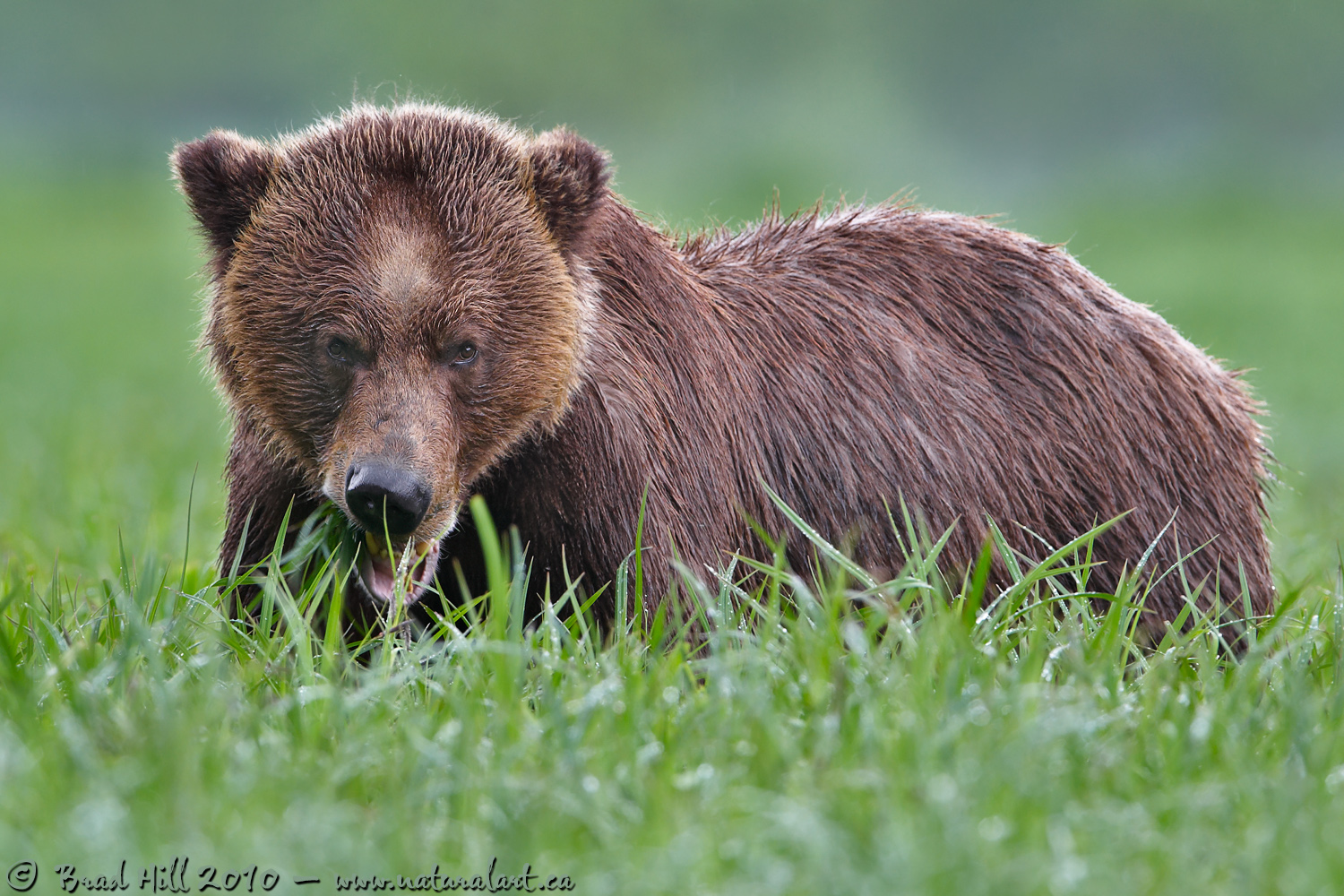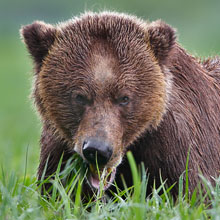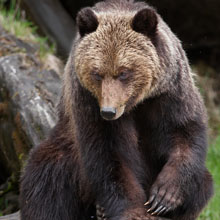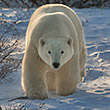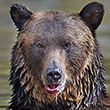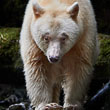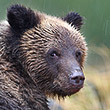Availability: Undetermined - Enquiries?
In the Field
Green, Green, Khutzeymateen. Khutzeymateen Inlet, BC, Canada. May 29, 2009.
The Khutzeymateen Inlet is one of the world's wilderness treasures. It's home to between 50 and 60 Grizzly Bears (with many more passing through on a regular basis). Because the innermost reaches of the inlet are off-limits to hunters (and the general public), and because the two outfitters that are permitted to take visitors into the sanctuary are exceptionally respectful of the inhabitants of the inlet, the bears are exceptionally gentle. The bears themselves offer visitors with a highly unique experience - they literally allow the few humans they encounter to share all aspects of their lives with them - the bears feed, play, sleep, mate, spar, and do "all things bear" right in front of you! Go to the Khutzeymateen in the spring (when the bears are feeding on the rapidly growing grasses and sedges) and you'll find yourself in one of the most lush and green realms on planet earth. Add a beautiful brown grizzly bear to the green, green Khutzeymateen and you have all the ingredients that wildlife photographers dream of!
For me this shot literally screams "Khutzeymateen!" This is a mature male grizzly and I shot this while he was in the presence of a receptive female bear. I loved the simplicity of the scene - simply a spectacular grizzly up to its neck in green sedges. I chose to use a long telephoto lens and shot with a nearly wide open aperture to soften the background into a pleasing green blur. While I normally try to avoid having two out-of-focus zones in a single image (I don't find that it looks too natural and I've always thought that having two focus gradients in a single image is a bit too complex visually for my taste), in this case I think the homogeneity of the foreground and background supports the dual out-of-focus zones.
ADDITIONAL NOTES:
1. This image - in all resolutions - is protected by copyright. I'm fine with personal uses of them (including use as desktop backgrounds or screensavers on your own computer), but unauthorized commercial use of the image is prohibited by law. Thanks in advance for respecting my copyright!
2. This image was captured during one of my two spring "Grizzlies of the Khutzeymateen" photo tours in May/June of 2009. Each year I offer trips into two different parts of the Great Bear Rainforest as well as one to photograph aquatic mammals and oceanscapes near the northern tip of Vancouver Island. And, in selected years, I also offer photo tours to locations to capture other highly sought-after subjects, such as various boreal owl species and wildlife of Canada's Arctic. Details about these trips can be found on the Photo Tours page of this website.
3. Like all wildlife photographs on this website, this image was captured following the strict ethical guidelines described in The Wildlife FIRST! Principles of Photographer Conduct. I encourage all wildlife photographers to always put the welfare of their subjects above the value of their photographs.
Behind the Camera
Green, Green, Khutzeymateen. Khutzeymateen Inlet, BC, Canada. May 29, 2009.
Digital Capture; Compressed RAW (NEF) 14-bit format; ISO 560.
Nikon D3 with AF-S Nikkor 600mm f/4G IF-ED II VR lens supported on Gitzo 1348 carbon fibre tripod with Wimberley head. VR turned to "On" and in "Tripod" mode. Autofocus set to M/a mode.
1/125s @ f5; -0.33 stop compensation from matrix-metered exposure setting (to preserve highlights along the top edge of the bear's head)
At the Computer
Green, Green, Khutzeymateen. Khutzeymateen Inlet, BC, Canada. May 29, 2009.
RAW Conversion to 16-bit TIFF, including first-pass/capture sharpening using Phase One's Capture One Pro 5. Three RAW conversions at different exposure settings. Exposure settings of 0 stops (for background and foreground) through to +0.5 stops (to recover shadow detail on the right side of the bear's face).
Further digital corrections on 16-bit TIFF file using Adobe's Photoshop CS4 and Light Craft's LightZone. Photoshop adjustments included compositing and masking of 3 exposure versions, selective saturation and de-saturation of colours, and selective sharpening for web output. Final tonemapping, balancing and tweaking performed using the Tonemapper/Re-light tool in LightZone.
Conservation
Green, Green, Khutzeymateen. Khutzeymateen Inlet, BC, Canada. May 29, 2009.
Ten percent of the revenue generated by this image will be donated to Raincoast*.
Species Status in Canada**: Special Concern (May 2002).
While Grizzly Bears (Ursus arctos) are not technically listed as "Endangered" in Canada, they have been extirpated from most of their historical range. Grizzly Bears are far more sensitive to intrusion/disturbance in their habitat than are Black Bears and are being increasingly forced into marginal habitat by human encroachment. The Great Bear Rainforest along the central and northern coast of British Columbia is one of the last strongholds of the Grizzly Bear in Canada, and even this population is coming under increasing pressure.
On December 18, 2017 the government of British Columbia banned grizzly hunting across the entire province. This major conservation victory came after decades of tireless work by many dedicated conservationists and ecologists and, most importantly, it reflects the opinion of the vast majority of British Columbians. And, it means that AT LEAST while the current government remains in power grizzlies are finally "safe" in British Columbia.
Now that we've at least temporarily won the battle to save grizzlies in BC, it's time to re-focus our efforts toward protecting ALL of BC's carnivores, including Gray Wolves, Black Bears, Cougars, Wolverines, and more! Simply put, there are no ecological, economic, or ethical arguments supporting the trophy hunting of carnivores.
In a great first step towards ending the hunting of carnivores throughout BC the Raincoast Conservation Foundation has developed a program designed to protect ALL carnivores within the Great Bear Rainforest. Details about this program can be found on this page on Raincoast's website. Check it out and, better yet, make a donation to help Raincoast purchase the remaining commercial hunting tenures in the Great Bear!
*The Raincoast Conservation Society (and Foundation) is an effective and efficient organization that has been fighting for protection of this unique habitat. If you are looking for a meaningful way to contribute to the conservation of this amazing ecosystem, Raincoast will provide maximal "bang" for your conservation dollars.
**as determined by COSEWIC: The Committee on the Status of Endangered Wildlife in Canada












